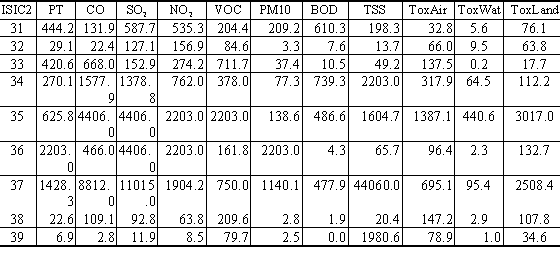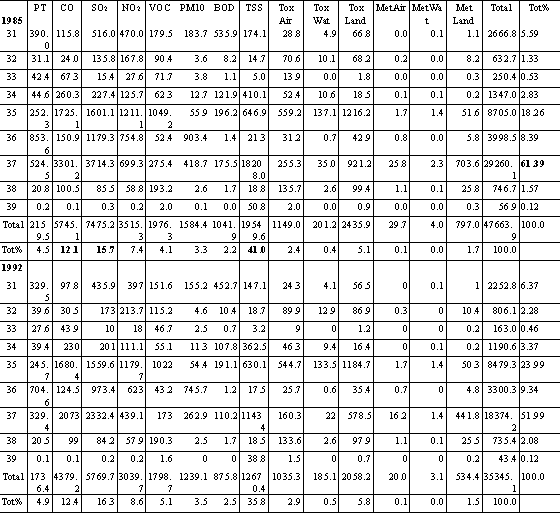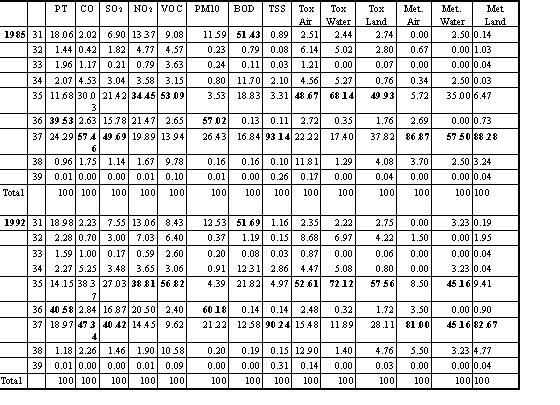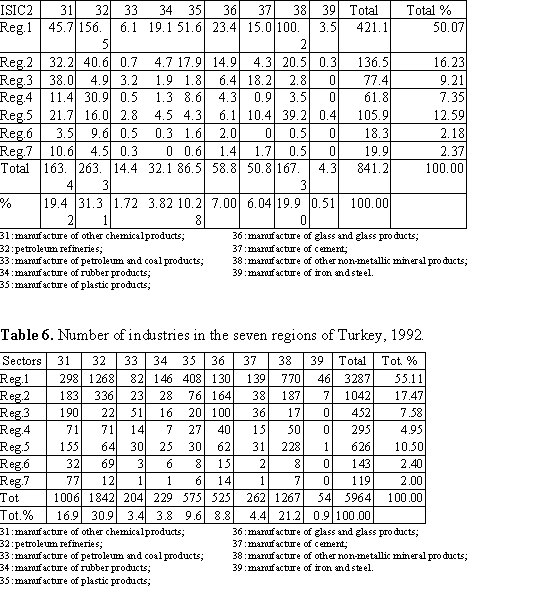

|
|
Earth Community Organization (ECO)
the Global Community Dr. Katalin K. Zaim Turkey kumar@central.murdoch.edu.au kzaim@bilkent.edu.tr for Discussion Roundtables 1, 11, 26, 28, and 36
Table of Contents | 1.0 Pollution Control Priorities Assessment with IPPS: the Case of Turkey
Dr. Katalin K. Zaim
Turkey Air, water and land pollution are well known problems linked with industrial production. The most common way to regulate polluting activities is htrough standards. Such a regulatory device has been recognized to be inefficient due to its high cost of implementation. Hence, if standards were to be used as a tool, at the implementation state one should focus only on the sectors, which would occur the lowest cost of abatement, and regions which would gain the highest benefit of abatement. To this end sectoral pollution intensities in a regional breakdown are identified. Such information is necessary for an optimal allocation of financial resources in the regulatory system. The computations are based on the IPPS method developed by Environment and Infrastructure Division of the Policy Research Department (PRDEI) group of the World Bank. The results indicate that the Turkish industrial production is responsible for most of the TSS, SO2, and CO emissions. Manufacture of chemical products created the largest amount of BOD emission. Plastic production caused NO2, VOC and polluted air, water and land with toxic pollution the most. Results showed that glass production is the most relevant PT and PM10 polluter, while cement manufacturing caused the highest level of CO, SO2, TSS. Region 1, which is the most industrialized region of the country, experienced the highest level of pollution, and abatement costs, but greatest benefit per pollution abated. At a 50% of abatement, the benefit/cost ratio turned out to be the highest compared to 100% and 25% of abatement. kumar@central.murdoch.edu.au kzaim@bilkent.edu.tr Introduction Industrial pollution plays a major role in the deterioration of nature when the level of pollution is above the carrying capacity of the ecosystem. There are approaches to limit and regulate the pollution emissions of industrial activities. These are standards, taxes and pollution permits. The choice among these alternatives depends on the administrative structure of a nation. The Turkish Ministry of Environment, which is established in 1993 sets standards for the polluting activities. International standards are taken as a point of reference while choosing these standards. However, regulatory activities have been either too little or inefficient. It is well known that such a regulatory system will not lead to an efficient outcome since it requires a strong bureaucratic control and financial support. The optimal allocation of financial resources in the regulatory system is of upmost importance especially for nations with insufficient funds. Different sectors and areas may have different pollution problems. Some will suffer primarily from air pollution while others may have severe water pollution or toxic pollution problems. Therefore, it is important to identify the impacts of different pollutants and their geographic correlation. Such correlation allows policy makers to simplify their analysis of the problem and its regulation. In this study, first, the magnitude of industrial pollution is assessed for 1985 and 1992 in Turkey. Second, the industrial sectors’ contributions to pollution emission and media contamination (land, water and air) are identified. Third, the regional pollution intensities, pollution abatement costs, benefits of abatement and benefit-costs ratios are computed for policy decisions. Data and Methodology The magnitude and impacts of industrial pollution is estimated by using the Industrial Pollution Projection System (IPPS) method developed by the Environment and Infrastructure Division of the Policy Research Department (PRDEI) in the World Bank (Hettige 1995). IPPS is a system for estimating pollution and abatement costs using industry data. IPPS emissions and cost parameters allow to conduct a benefit cost analysis of the impact of industrial pollution. Pollution intensities and abatement cost estimates of IPPS were obtained by merging US Census Bureau data and Environmental Protection Agency’s (EPA) U.S.A. data for 200,000 US plants (Hettige 1995 and Hartman 1995). The IPPS consists of pollution intensity indexes expressed as a ratio of pollution per unit of manufacturing activity (pollutant output intensity = pollutant output/ total manufacturing activity). The IPPS sources provide pollution intensity indexes for pollutants such as Particulate (PT), Sulfur Dioxide (SO2), Nitrogen Dioxide (NO2), Volatile Organics (VOC), Particulate Matter10 (PM10), Biological Oxygen Demand (BOD), Total Suspended Solids (TSS), Toxics emitted to air (Toxair), Toxic Water (ToxWat), and Toxic Land (ToxLand). At each ISIC level the IPPS reports the pollution intensities with respect to three measures of manufacturing activity. These are value of output, value added and employment. In our study the pollution indexes expressed in tons/ 1000 employees at two digit ISIC levels are applied (Table 1). As Hettige underlines, employment-based intensities may be preferable for pollution projection in developing countries. The reasons provided are: 1.effective environmental regulation is thought to be quiet income-elastic; 2. sectoral pollution is thought to be responsive to effective environmental regulation in many cases; 3. most cross-country econometric studies of sectoral labor demand find relatively high wage elasticities. Hettige concludes that both sectoral pollution and sectoral labor demand will rise substantially as we move from richer (high-wage, high - regulation) to poorer (low-wage, low-regulation) economies. Since pollution and employment vary in the same direction, the variation in pollution intensity with respect to employment (P/E) may well be less than variation in pollution per unit of output. Table 1. Pollution intensity indexes (tons/ thousand employees). 
Source: World Bank/PRDEI, Industrial Pollution Projections Project The abatement cost coefficients are provided for PT, SO2, NO2, VOC (Table 2). The coefficients are reported as US$ 1984 per ton abated. All the costs are average costs. Table 2. Abatement cost coefficients (1984US$/tons of pollution). 
The data required to compute the sectoral pollution emissions, abatement costs and the regional impacts for the Turkish industrial sectors are: employment rate; the geographic distribution of the industries; population in the towns and IPPS coefficients. The Turkish census data is organized by the ISIC industrial code system. The employment levels and number of industries in the seven region of Turkey are obtained from the Annual Manufacturing Industry Statistics (1985 and 1992). First, the pollution intensities (tons per 1000 employee) derived from IPPS are calculated according the employee levels reported for the two digit industries for 1985 and 1992. The results provide information on the pollution intensity variation between these two years. Second, the pollution intensities and abatement costs per unit of output are also computed for each industry in Turkey for 1992. The pollution and costs estimates are disaggregated by the seven regions of Turkey to create an estimate of geographical pollution "density". While pollution load results give a good idea of the location of pollution, it does not shade light on the health impacts, material damage or other environmental damage. To accurately estimate the impact of pollution reduction on health, information on ambient environmental quality and dose response functions are required. In the absence of such information, Hettige recommended to use the regional population as a weight for pollution damage. Benefit is defined as pollution per population density per km2. Abatement costs of 10%, 25%, 50%, 80% and 100% reduction of a specific pollution are computed for each sector and region. The 100% abatement costs are obtained by multiplying the computed sectoral pollution expressed in tons with the IPPS abatement costs coefficient expressed as cost/tons of pollution. Similar method is used, under the assumption that 10%, 25%, 50% and 80% of the emission is abated. The results help to identify sectors and regions where the abatement of a ton of a given pollutant would be the cheapest. In addition, benefit – cost (B/C) ratio is also computed as the ratio of pollution per capita per km2 divided by the abatement costs. The B/C ratio is obtained for 10%, 25%, 50%, 80% and 100% abatement of the major pollutants for the seven regions of the country. From these results, one can see that cost-effective interventions would first deal with the region, which would bring the highest return. Furthermore, identifying heavily polluting sectors are important since it enables us to focus regulatory actions on particular firms and allows to investigate possible employment and growth impacts of stronger anti-pollution measures. Results Pollution intensities such as: PT, CO, SO2, NO2, VOC, PM, BOD, TSS, Toxic-Air (ToxAir), Toxic -Water (ToxWat), Toxic- Land (ToxLand), Metal - Air (MetAir), Metal-Water (MetWat), and Metal-Land (MetLand) are estimated for the nine 2 digit ISIC sectors (31-39) for the 1985 and 1992. The sectors 31 to 39 consist of: manufacture of other chemical products, petroleum refineries, manufacture of petroleum and coal products, manufacture of rubber products, manufacture of plastic products, manufacture of glass and glass products, manufacture of cement, manufacture of other non-metallic mineral products, and manufacture of iron and steel respectively. The results are depicted in Table 3 and in percentage form in Table 4 for the years 1985 and 1992. The results indicate that TSS contributes 41.02% to the total pollution load, while SO2 and CO’s percentage contribution are 15.7% and 12.01% respectively in the year 1985. Pollution such as NO2, PT, VOC, PM10 and BOD contributed 7.38%, 4.53%, 4.15%, 3.32% and 2.19% respectively to the annual pollution intensity in 1985 (Table 3). Sector 37 (Manufacture of Cement) is shown to be the major contributor of TSS, SO2 and CO with 93.14%, 49.69% and 57.46% of pollution respectively in 1985. This sector is also found to be the most severe metal air, metal water and metal land polluter with contribution of 86%, 57% and 88% respectively. Sector 36 (Manufacture of Glass and Glass Products) is the most important PT polluter (39.56%). Sector 35 (Manufacture of Plastic Products) emitted the largest amount of NO2, VOC and polluted air, water and land with toxic pollution (48.6%, 68.1% and 49.9%). Sector 31 (Manufacture of other chemical products) contributed 51.43% to the 1985 BOD pollution. Similar trends are observed for 1992. Table 3. Sectoral pollution intensities for 1985 and 1992 (103 tons). 
31: manufacture of other chemical products; 32: petroleum refineries; 33: manufacture of petroleum and coal products; 34: manufacture of rubber products; 35: manufacture of plastic products; 36: manufacture of glass and glass products; 37: manufacture of cement; 38: manufacture of other non-metallic mineral products; 39: manufacture of iron and steel. Table 4. Sectoral pollution for the 1985 and 1992 period (%). 
31: manufacture of other chemical products; 32: petroleum refineries; 33: manufacture of petroleum and coal products; 34: manufacture of rubber products; 35: manufacture of plastic products; 36: manufacture of glass and glass products; 37: manufacture of cement; 38: manufacture of other non-metallic mineral products; 39: manufacture of iron and steel. To identify the regional impact of pollution, the pollution intensities, cost of abatement, benefit of abatement and benefit/cost ratios are computed for the seven regions of Turkey in 1992. The seven regions (I to VII) correspond to the region of Marmara (Balikesir, Bilecik, Bursa, Canakkale, Edirne, Istanbul, Kirklareli, Kocaeli, Sakarya and Tekirday), Aegean (Aydin, Afyon, Denizli, Izmir, Kutahya, Manisa, Mugla, and Usak), Black Sea (Amasya, Artvin, Bolu, Corum, Giresum, Gugushane, Kastamonu, Ordu, Rize, Samsun, Sinop, Tokat, Trabzon, Zonguldak, Bayjurt, and Bartin), Mediterranean (Adana, Antalya, Burdur, Hatay, Isparta, Icel, and K.Maras), Central Anatolya (Ankara, Cankiri, Eskisehir, Kayseri, Kirsehir, Konya, Nevsehir, Nigde, Sivas, Yozgat, Aksaray, Karaman and Kirikkale), South Eastern Anatolia ( Adiyaman, Diyerbakir, Gaziantepe, Mardin, Siirt, Sanliurfa, Batman and Sirnak) and Eastern Anatolia (Agri, Bingol, Bitlis, Elazig, Erzincan, Erzurum, Hakkari, Kars, Malatya, Mus, Tunceli, Van, Igdir, and Ardahan) respectively. For the regional analysis, first the level of employment and number of industries are determined and given in Table 5 and 6. Second, the pollution intensities, and benefits of abatement are calculated (Table 7 and 8). Third, the abatement costs and benefit/cost ratios are computed for 100%, 80%, 50%, 25% and 10% of abatement. Table 5. Regional and sectoral employment rate in 1992 (in 103). 
Table 7. Regional pollution in 1992 (103 tons) 
The regional employment rate, number of industries, total pollution, pollution per capita/km2 are reported in the Figure 2 for comparison purposes. 
Figure 1. Regional distribution of level of employment, number of industries, level of pollution and pollution/capita/km2 in 1992. When regions are compared according to their employment rate, number of industries, estimated pollution intensity, and pollution per capita per km2, one can observe that the highest employment rate (50.07%) and the largest number of industries (55%) are in Region 1 (Table 5 and 6). Sector 32 (petroleum refineries) and 38 (manufacture of other non-metallic mineral products) are the most common ones in this region. Due to high industrialization, this region is responsible of 40% of the total pollution with the highest pollution density per capita per (657.09 103 tons/capita/km2) (Table 7). The most significant pollutants in this region are TSS with 37%, and SO2 with 17% contribution (Table 8). When ranked according to the level of total pollution, Region 3 with 22% and Region 4 and 5 with 14% assume the second highest share. The other regions experienced a mild level of pollution with shares between 5 to 1% (Table 6). The Region 3 with 7.58% of industrialization and 9.21% level of employment experiences 22.1% pollution. Sectors 31 and 36 play the most significant role in the region. Pollutants such as TSS, SO2 and CO contribute mostly to the total pollution with 921.8*103, 241.45*103 and 185.05*103 tons respectively. Regions 2 and 5 with 17.47% and 10.5% of industrialization, and with 16.23% and 12.59% of employment produced 14.4% and 14.9% of the total pollution respectively. Sector 32 and 36 play the most significant role in Region 2, while sector 31 and 38 are the most relevant ones in Region 5. In both regions, TSS, SO2 and CO are the major pollutants. For the benefit/cost ratio computation, first the benefits are computed. More specifically, the pollution share per capita per km2 is computed assuming 10%, 25%, 50%, 80% and 100% levels of abatement. Also the abatement costs for each sector are computed and aggregated for the relevant regions. Abatement costs are computed for the same scenario as for the benefit computations. Finally, the benefit/ cost ratio is obtained by dividing the benefit values with the cost figures. The results of the benefit/cost ratio and abatement costs for 10%, 25%, 50%, 80% and 100% level of abatement are reported in Figure 2. Figure 2. Regional total abatement costs and benefit/cost ratios for the year 1992. For 100% of abatement, Region 1 would occur the highest abatement costs (2.25* 104 1984 US $) and benefit per cost of abatement (6.12). Whereas, at this level of abatement Region 7 would pay the lowest abatement costs (0.12*104 1984 US $) and would gain the lowest benefit 0.98. At a lower abatement levels the costs of abatement and benefit/cost ratios depict a similar trend (Figure 3). The results indicate an increasing trend at 50% of abatement, which might be a good indicator of threshold level. More specifically, Costs of abatement at levels above 50% are more than the benefit gained from such level of abatement. This decreasing B/C ratio above 50% of abatement might be a good indicator of threshold level. More specifically, the results indicate that abating at levels higher than 50% would bring just higher cost but lower benefits per unit of abatement. Conclusion The IPPS method developed by the PRDEI in the World Bank allowed us to compute the yearly pollution intensities, toxic and metal pollution emissions to air, water and land for the industrial activities. The computations are performed for the years 1985 and 1992. The results indicate that the most relevant pollutants produced by industries are TSS, SO2, and CO. Toxic and metal pollution effected land mostly. Sectors responsible for the highest level of pollution are manufacture of other chemical product (31), manufacture of plastic product (35), manufacture of glass and glass product (36) and manufacture of cement (37). Manufacture of other chemical products created the largest amount of BOD emission. Plastic production caused NO2, VOC and polluted air, water and land with toxic pollution the most. Glass production results in the highest levels of PT and PM10 pollution. Cement manufacturing on the other hand caused the highest level of CO, SO2, TSS, metal air, metal water and metal land pollution. The regional distribution of pollution intensities, benefits of abatement, abatement costs and benefit/cost ratios are also computed for the year 1992. The results indicated that region 1 experienced the highest level of pollution, and region 3 the second highest. The other regions were exposed to lower level of pollution intensities. Similar results are obtained for the pollution per capita per km2. Since region 1 is exposed to the highest level of pollution, the abatement costs are also the most significant ones in this region; hence, the benefit/cost ration is greatest in this region at each level of abatement. As pollution abatement decreased from 100% to 80%, 50%, 25% and 10% the abatement costs and benefit/cost ratios for each region decreased proportionally. However, at 50% of abatement the benefit/cost ratio is the highest compared to 100% and 25% of abatement. This indicates that the most cost efficient policy would be to request a 50% of abatement in all regions, since at a higher level of abatement the benefit gained per cost of abatement is decreasing at an increasing rate, whereas the benefit/cost ratio reaches its highest value at 50% of abatement. References Annual Manufacturing Industrial Statistics. 1985. State Institute of Statistics Prime Ministry Republic of Turkey. Annual Manufacturing Industrial Statistics. 1992. State Institute of Statistics Prime Ministry Republic of Turkey. Hettige, M., M. Huq, S. Pargal, and D. Wheeler. 1996. "Determinants of Pollution Abatement in Developing Countries: Evidence from South and Southeast Asia", World Development (forthcoming). Hettige, M., and D. Witzel. 1996. Pollution Control Priorities for Mexico. World Bank. Policy Research Department (mimeo). Hettige, M., M. Singh, S. Pargal, and D. Wheeler. 1995. Patterns in Pollution Intensity: Formal and Informal Regulation of Industrial Pollution in the U.S. and Indonesia. Annual Meetings of American Economic Association. Washington, D.C. January 1995. Hettige, M., P. Martin, M. Singh, and D. Wheeler. The Industrial Pollution Projection System. Policy Research Working Paper No: 1431. The World Bank, Policy Research Department, Environment, Infrastructure, and Agriculture Division, March, 1995.
Send mail to gdufour@globalcommunitywebnet.com with
questions or comments about this web site. |